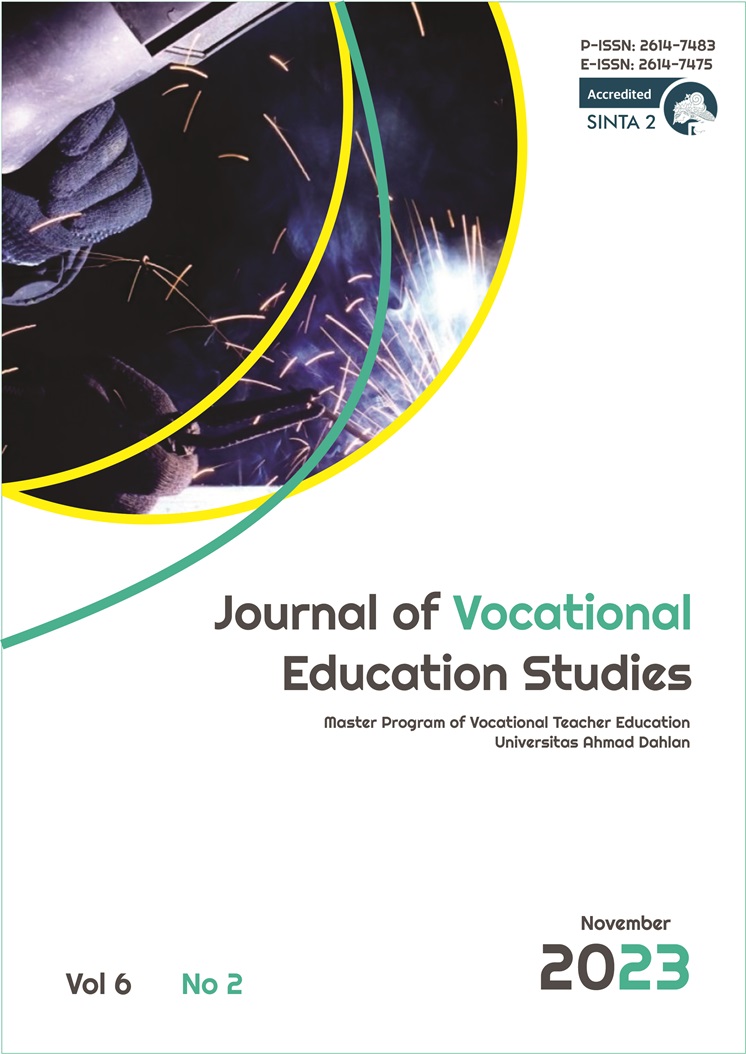Development of a Mobile Menu Book as a Media For Learning Food Service in Tourism Schools
DOI:
https://doi.org/10.12928/joves.v6i2.8654Keywords:
menu mobile book , media learning , food serviceAbstract
The important to remember that technological progress is unpredictable, and the landscape of immersive and interactive systems may have seen significant progress. Developers and innovators are constantly exploring and experimenting with new possibilities, making the future of immersive technology exciting and full of potential as a means to improve education. The research seems to adopt a mixed-methods approach, utilizing both qualitative methods for needs analysis and design stages, and quantitative methods for testing the product's effectiveness. By involving both teachers and students in the development process, the application can better meet their specific needs and preferences. The validation data collected from the assessment by validators suggests that the application has been well-received and is considered valid for use in food service learning. With an average percentage of 85.25% in the valid category, it implies that the application meets the required standards and requirements for an effective learning tool. Overall, the Android-based learning media application holds the potential to contribute significantly to the field of education, particularly in cooking learning. As technology continues to advance, similar applications tailored to other industries and fields of study can also play a crucial role in addressing the increasing demand for skilled human resources in various industries.
References
abd Ghofur. (2020). Pengembangan Media Pembelajaran Scan Barcode Berbasis Android Dalam Pembelajaran Ips. EduTeach : Jurnal Edukasi Dan Teknologi Pembelajaran, 1(2), 144–152. https://doi.org/10.37859/eduteach.v1i2.1985
Akbar, A. (2021). Pentingnya Kompetensi Pedagogik Guru. JPG: Jurnal Pendidikan Guru, 2(1), 23. https://doi.org/10.32832/jpg.v2i1.4099
Anyan, A., Ege, B., & Faisal, H. (2020). Pengembangan Media Pembelajaran Interaktif Berbasis Microsoft Power Point. JUTECH : Journal Education and Technology, 1(1). https://doi.org/10.31932/jutech.v1i1.690
Audie, N. (2019). Peran Media Pembelajaran Meningkatkan Hasil Belajar Peserta Didik. Prosiding Seminar Nasional Pendidikan FKIP, 2(1), 589–590.
Crompton, H., & Burke, D. (2018). The use of mobile learning in higher education: A systematic review. Computers and Education, 123(September 2017), 53–64. https://doi.org/10.1016/j.compedu.2018.04.007
Dede, D., Abdullah, A. G., Mulyanti, B., & Rohendi, D. (2019). Review TVET learning innovation: Augmented reality technology for virtual 3D laboratory. Journal of Physics: Conference Series, 1402(7). https://doi.org/10.1088/1742-6596/1402/7/077062
Efrain, R., Manggopa, H. K., & Liando, O. E. S. (2021). Pengembangan Media Pembelajaran Berbasis Android Mata Pelajaran Ipa Sekolah Mengengah Pertama. Edutik : Jurnal Pendidikan Teknologi Informasi Dan Komunikasi, 1(4), 335–341. https://doi.org/10.53682/edutik.v1i4.2068
Irwansyah, F. S., Yusuf, Y. M., Farida, I., & Ramdhani, M. A. (2018). Augmented Reality (AR) Technology on the Android Operating System in Chemistry Learning. IOP Conference Series: Materials Science and Engineering, 288(1). https://doi.org/10.1088/1757-899X/288/1/012068
Jayatilleke, B. G., Ranawaka, G. R., Wijesekera, C., & Kumarasinha, M. C. B. (2019). Development of mobile application through design-based research. Asian Association of Open Universities Journal, 13(2), 145–168. https://doi.org/10.1108/AAOUJ-02-2018-0013
Klimova, B. (2019). Impact of Mobile Learning on Students. Education Sciences, 9(2), 8. https://www.mdpi.com/2227-7102/9/2/90
Kuntadi, I., Widiaty, I., Yulia, C., & Mubaroq, S. R. (2019). An android-based e-observation application on lesson study learning in vocational high schools. Journal of Engineering Science and Technology, 14(5), 2499–2508.
Posumah, A., Waworuntu, J., & Komansilan, T. (2021). EduTIK: Jurnal Pendidikan Teknologi Informasi dan Komunikasi. EduTIK: Jurnal Pendidikan Teknologi Informasidan Komunikasi, 1(6), 675–687. https://ejurnal.unima.ac.id/index.php/edutik/article/view/3293
Wardina, U. V., Jalinus, N., & Asnur, L. (2019). Kurikulum Pendidikan Vokasi Pada Era Revolusi Industri 4.0. Jurnal Pendidikan, 20(1), 82. https://doi.org/10.33830/jp.v20i1.843.2019
Yildiz, R. (2020). Handbook of Research on Educational Communications and Technology. In Contemporary Educational Technology (Vol. 1, Issue 1). https://doi.org/10.30935/cedtech/5962
Yulia, C., Hasbullah, H., Nikmawati, E. E., Mubaroq, S. R., Abdullah, C. U., & Widiaty, I. (2018). Augmented reality of traditional food for nutrition education. MATEC Web of Conferences, 197, 2–5. https://doi.org/10.1051/matecconf/201819716001
Downloads
Published
Issue
Section
License
Copyright (c) 2023 Universitas Ahmad Dahlan

This work is licensed under a Creative Commons Attribution-ShareAlike 4.0 International License.
Authors who publish with Journal of Vocational Education Studies (JOVES) agree to the following terms: Authors retain the copyright and grant the Universitas Ahmad Dahlan right of first publication with the work simultaneously licensed under a Creative Commons Attribution License (CC BY-SA 4.0) that allows others to share (copy and redistribute the material in any medium or format) and adapt (remix, transform, and build upon the material) the work for any purpose, even commercially with an acknowledgement of the work's authorship and initial publication in Universitas Ahmad Dahlan. Authors are able to enter into separate, additional contractual arrangements for the non-exclusive distribution of the journal's published version of the work (e.g., post it to an institutional repository or publish it in a book), with an acknowledgement of its initial publication in Universitas Ahmad Dahlan. Authors are permitted and encouraged to post their work online (e.g., in institutional repositories or on their website) prior to and during the submission process, as it can lead to productive exchanges, as well as earlier and greater citation of published work (See The Effect of Open Access).










.png)



